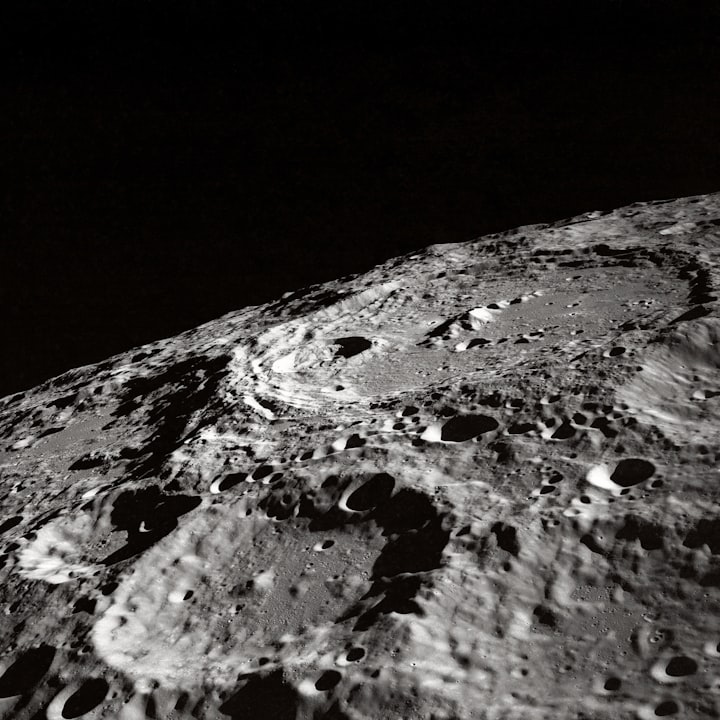Weightless
A tale of moon colonization and dystopia
Chapter 1
Nobody can hear a scream in the vacuum of space. Or so they say.
I remember chatting about this idea with a group of friends, years ago, beers in hand. So jovial, so removed from the concept back then.
“Of course you can’t hear sound in space! There’s no air for it to travel through.”
Obvious to a group of engineers. It makes me wonder now, if we were philosophers instead of engineers, would this discussion have gone differently? What’s the classic adage – if a tree falls in the forest and no one is there, does it still make a sound? Years ago, my mathematical mind wouldn’t have considered this any further than by using the simple rules of physics. Now my thoughts are different - having seen what I’ve seen, and heard (or not heard) the haunting absence of sound.
Unfortunately, I can’t make myself forget the countless people I’ve now seen drift away into the nothingness of space, the horrified “O” of their lips as they attempted a scream nobody would ever hear. Then again, if I was blessed with forgetting, I wouldn’t be able to bring a voice to these people. The ones that were cast off by a corrupt society in space. They say nobody can hear a scream in the vacuum of space. I say this is part of the problem.
☾ ☾ ☾ ☾ ☾ ☾ ☾ ☾🌘🌗🌕
I remember when I was first offered the Space Colonies fellowship. I was so green, full of boundless optimism about how it could be a game changer for my small Earthly existence. This was before I knew about the dark side – pardon the pun – of Moon Life.
I’d always been intrigued by physics and engineering. My interest in social dynamics came later, when it became uncomfortably intertwined with the technological revolution. I suppose the relationship between technology and societal hierarchy isn’t altogether unsurprising when you consider the implications of colonizing the Moon. Of course, the Moon colonization began with good intentions, as many things do. It was an opportunity to maximize space (again, pardon the pun) and escape the slow deterioration of Earth.
This alternative method of life was easily accessible to the rich, and later incentivized to other income groups so that an ecosystem of jobs could be constructed. This continued for generations - a bustling economy built on the Moon, technology developing at rapid-fire rate, even trade deals established between Earth and the Moon. The last time I checked, the Moon population had surpassed a couple million individuals.
From a living-on-Earth perspective, we always received snippets of news about Moon life. The Moon Cities seemed almost utopian - glorious and futuristic. Peaceful and exotic. The breadth of Moon technology far exceeded that of Earth’s. Synthetic atmospheres (colloquially, “Synths”) were available to individual consumers so that they could breathe freely and easily - a personalized bubble of oxygen and gas exchange that orbited an individual’s head like an invisible circulating helmet. In public areas, synthetic atmospheres ranged over entire long-range spaces, for the benefit of crowd sharing.
Microgravity suits (colloquially, “Microgravs”) became commonplace, making bipedal movement coordinated and flawless instead of bouncy and uncontrolled on the Moon. This was deemed a basic human need considering that the Moon’s gravity is about 1/6th as powerful as that of Earth’s. I t allowed for the execution of of human motion necessary for comfortable space living.
Microgravs began as simple garments for functional use, later expanding to fashion-forward pieces that became the inspiration for Halloween costumes on Earth. As a mechanical engineer, I followed the evolution of these technologies closely, with dreams of working for these companies following my research degree.
☾ ☾ ☾ ☾ ☾ ☾ ☾ ☾🌘🌗🌕
I couldn’t have been more excited when I was offered the opportunity to experience Moon technologies firsthand. The offer: live on the Moon for 6 months, job shadow at respective innovation hubs, and be fully immersed in a culture that I had only read about or seen in holograms. Accepting the fellowship was a no-brainer.
Within a whirlwind week I had packed my earthly possessions and readied myself for transport to the Moon Holding Station where I would be acclimated to the foreign planetary body. This was where my body kinematics would be used to ensure a personalized fit to my own Micrograv suits, as well as for my own Synth, based on state-of-the-art sensors that detected each and every movement that my body could ever make. The Moon Holding Station was tethered just off of the moon, where I would rest for two days before making the final journey to my new lunar lodgings.
An odd mixture of exhaustion and elation accompanied me on this voyage. I had slept much of the 2-day journey to the moon, but my body still felt tired, much like an intercontinental airplane ride. Looking back, I should have trusted the strange things I witnessed on the way into the moon’s core. At the time, I sloughed off my uncertainties and wrote them off as an overtired brain and a foreigner’s obliviousness to new surroundings.
☾ ☾ ☾ ☾ ☾ ☾ ☾ ☾🌘🌗🌕
As I travelled to the Moon’s core, my eyes were glued to the barren environment, almost hostile in its rocky emptiness. I was in a state of sensory overload that felt almost dreamlike. I knew from the mainstream media that populated areas of the Moon were not barren at all, but the Moon outskirts still clearly carried the vibes of an impoverished desert.
The core was situated about 1000km “inland” and located within the Moon’s largest crater – the Copernicus Crater. Our means of transportation was that of a solar-powered modified jet, whizzing across the lunar landscape at breakneck speed. When we slowed down, I assumed we were nearing our destination. However, the pilot of our small vessel furrowed his brow in worried concentration.
“Solar storm,” was all he said.
Based on my knowledge of solar energetics, I knew this could potentially affect our trek. Old versions of solar panels stored energy for later use. New versions of solar hardware converted solar energy in real-time with little storage capacity; this is more efficient unless there’s some type of solar disruption. Fortunately, our transportation machine was equipped with both types of solar technologies, and we would be solely dependent on the reservoir of stored energy for the remainder of the offending solar event. This meant that we’d still reach our destination, but on a slower timeline than anticipated. I didn’t mind, based on my blatant curiosity for all Moon-related experiences.
I realized that this unique set of circumstances presented a novelty that most Moon visitors didn’t get. By travelling more slowly, I was able to discern details in the surrounding landscape that would have otherwise been a blur. As we covered ground, I noticed with surprise that there was evidence of human habituation in the form of small villages – primitive looking and reminiscent of the destitute human settlements on Tatooine, the harsh desert planet in the Star Wars franchise.
Huh, I thought, I don’t remember seeing that in any of the brochures.
Were these abandoned remnants of initial colonization attempts on the Moon? I squinted into the distance, looking for signs of life. For hours, there were no distinguishable signs of outdoor movement. Then suddenly, as I was starting to settle into trance-like exhaustion, I saw them.
They resembled a group of beings. I say “beings” because their movements were closer to machine-imitative movements than biological movements. I could make out limbs – arms and legs. But the movements resembled a comedic satire of humanoid movements. They were slow and exaggerated – unsynchronized and slightly weightless. These beings seemed to anchor themselves to the Moon’s surface using pieces of jagged metal that were burrowed into the ground. Their apparel seemed antiquated and medieval – similar to first-generation Micrograv suits that I’d seen in space museums on Earth. Whatever they were, they were clearly not adapted to the Moon’s microgravity conditions. They lacked the seamless grace that accompanied the standard Micrograv suits that were considered the norm these days.
I struggled to make sense of what I was seeing. Perhaps this was some type of experiment testing old prototypes? Or perhaps they were moving more cohesively than I thought, and my exhaustion was painting a strange picture in my mind. Hindsight is a funny thing, because as I look back now, this was the first of many clues pointing to the flawed humanity that I would observe on my Moon stay.
☾ ☾ ☾ ☾ ☾ ☾ ☾ ☾🌘🌗🌕
The Moon’s core city (called The Primary) was a replica of what I had seen advertised on Earth. I knew that the Moon also had Secondary cities, smaller in size and population, with numbered names in order of chronological colonization. Clearly Lunar city planners weren’t winning any awards for creativity. At the same time, I appreciated the simple efficiency of the way things worked up here, less burdened by human ambiguity and bias (or so I thought at the time).
As far as I had been taught, there were only Primary and Secondary cities on the moon. I wasn’t sure how to make sense of what I had observed on my way to The Primary, and if that meant there were mysterious “other” humans outside of the Primary and Secondary Moon cities. My accommodations were in the Center of The Primary, a futuristic tech hub of elite-looking sleek establishments. As I stepped off my transport vehicle, it was my first time donning my Micrograv suit in truly outdoor Moon conditions. I sliced through the air easily and smoothly, feeling exactly as “weighted” as I had on Earth. It’s quite incredible if you think about it - achieving perfectly adapted movements on a planet outside of Earth.
My apartment (provided by the fellowship) was also perfectly acclimated in terms of oxygen and gravity. I stayed there long enough to drop off belongings and then embraced my need to explore, still running on adrenaline. My building was next to a Shared Space – a synthetic atmosphere stretched across a large surface area for public use.
As I approached the entrance, I was baffled to see a sign – “Key Card Access Only.” My understanding was that shared spaces were non-discriminatory to all Moon users. I must have missed it in the news that some of these spaces had been privatized. I had received a Key Card at the Holding Station, but was unsure of whether all members of the population were privy to the same benefit. Spoiler alert: they weren’t.
Egged on by my obliviousness to this first hint of Moon classism, I entered the artificial park. It was partially supported by holograms, but also had real green space. It truly did feel like I was back on Earth, albeit with an added eerie perfectionism caused by the hologram mimicry.
Since I didn’t technically need a Micrograv suit within the synthetically aerated space, I took it off and examined it for the first time. I assumed it must run on the most current operating system that existed up here. Looking around, I noticed a wide variation of suits, some with extra features and aesthetics, but all looking at least as modern as my own. I felt a thrill run through me at the thought that I’d be able to dissect the inner workings of these suits, and focus on the hardware and software of it all. This is why I was here.
☾ ☾ ☾ ☾ ☾ ☾ ☾ ☾🌘🌗🌕
When I left the seemingly exclusive park, I noticed that there was a much wider variation of suits, with some subtle observable differences in movement ease. This metric is referred to as “adaptability” by engineers and designers. It’s used to describe and market Micrograv suits to consumers by assigning an “Adaptability Score” to each. This score is influenced by many parameters: sensor placements, sensitivity thresholds, and activation triggers, as well as accompanying software versions.
I wondered at the availability of each software update. I had been under the impression that they were open source and freely available for all that were dependent on them. But based on the spectrum of different adaptabilities that I could see, perhaps this was not the case. In a different train of thought, I pondered at the adjustments that I could make to these suits. It sounded like something I could fixate on - a fun challenge.
I had a few days before the start of my fellowship, so this seemed like as good a t ime as any to start my engineering journey. Perhaps if I made some unique alterations, I could even impress my employers when I arrived for my first day. I knew that up here, freelance engineers and mechanics had a thriving field of their own, since the entire economy was based on the required technologies doing their respective jobs.
Living off of a student stipend, I navigated a touch screen in my room to find one of the more economical (i.e., cheap) engineers that I could consult with before I began meddling with my Micrograv suit on my own. The man I found seemed to be based on the edge of the city instead of the busy Center. I reasoned it could be a good opportunity to see some of the city on my way there.
I noticed a trend on my way to the city outskirts. Perhaps it was my imagination, but the further I strayed from the Center, the more I noticed people with less cohesive movements. They seemed…biomechanically challenged.
In another bizarre turn of events, I witnessed a man tripping over his own feet (something that seemed implausible considering the semi-automated suit we all wear on the Moon). The most bizarre part was that it looked like he was suffocating as he fell – gasping and spluttering. I wondered how this was possible, considering the synthetic atmosphere was supposed to provide a thick layer of protection around the head, taking into account sudden movements. Was his Synth glitching? Perhaps he had a respiratory illness. I brainstormed potential explanations, but at this point my engineering brain was piqued.
☾ ☾ ☾ ☾ ☾ ☾ ☾ ☾🌘🌗🌕
When I arrived at the engineering consultancy, an older man greeted me. I noticed he wore an older style Micrograv suit, that seemed to be rigged with countless add-on features. I wondered why he didn’t wear something similar to the state-of-the-art suit that I had been given. I mentally added that to my list of questions.
The engineer, Norm, had a gruff appearance, tolerating my excitement but looking worn and drained. He informed me that private clients were often hiring him for trendy add-ons to their MicroGravs and Synths. Many of these were based on transient fads, and some were permanent upgrades.
U pon the mention of permanent upgrades, I raised my eyebrows. I assumed the Moon population collectively received coordinated software updates as they were released to the public. I didn’t realize it was possible to privately acquire substantial upgrades, naively believing that every person would have access to the same core features.
I knew that many of the aged “obsolete” software versions were phased out over time, but that Moon laws had been passed to ensure a standard of care to all individuals in terms of survival technology. Funny how on Earth, “standard of care” would refer to access to medical professionals and healthcare. On the Moon, it referred to access to engineering professionals and technology. I suppose the hierarchy of needs changes when oxygen and gravity aren’t guaranteed.
After chatting for an eternity about hardware specifics, I asked Norm why he hadn’t upgraded to the latest Micrograv suit.
“I keep most of my income for non-profit work,” he responded.
I wondered what non-profit work would entail up here, since I had assumed that every person had some baseline level of wealth. This was how the Moon economy was portrayed to us on Earth.
Noticing my contemplation, he added “It’s probably better if I show you. As long as you keep quiet about it.”
I nodded conspiratorially. In my experience, most engineers had a code of trust between them, ever since they became more highly regulated by the governments. Norm gestured for me to follow him, and we descended into his back room, where all my preconceived notions of Moon life were shattered.
About the Creator
Spacey McGee
Lover of sci-fi, futurism, and strange ideas







Comments
There are no comments for this story
Be the first to respond and start the conversation.